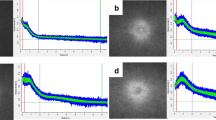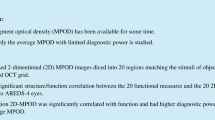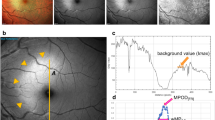Abstract
Introduction
The purpose of this study was to determine macular pigment optical density (MPOD) in patients with macular degeneration as well as in patients with non-proliferative diabetic retinopathy.
Methods
Fifty-one phakic patients with either age-related macular degeneration (60 eyes of 30 patients; average age, 70.9 years) or non-proliferative diabetic retinopathy (42 eyes of 21 patients; average age, 61.7 years) were included in this cross-sectional study. Within the groups, patients were divided into those suffering from macular oedema and those with no oedema. An intra-subject comparison between eyes was carried out in both groups. Data were investigated on the basis of the coefficient of determination (R 2). Macular pigment optical density was measured by fundus reflectometry using the one-wavelength reflection method (Visucam 500; Carl Zeiss Meditec AG, Jena, Germany), in conformity with the method described by Schweitzer et al. (2010). We evaluated the maximum optical density in the measurement area (max OD) and the average optical density across the reference area in the measurement area (mean OD). Specifically, the influence of macular oedema on macular pigment optical density was examined. The subsequent measurement of retinal thickness was carried out by spectral-domain optical coherence tomography (Spectralis SD-OCT, Heidelberg Engineering GmbH, Heidelberg, Germany).
Results
The current study included two groups. The first group consisted of patients with non-proliferative diabetic retinopathy, as follows: no macular oedema on either side (max OD: R 2 = 43.2 %, p = 0.16; mean OD: R 2 = 68.7 %, p = 0.04); one-sided macular oedema (max OD: R2 = 16 %, p = 0.60; mean OD: R2 = 100 %, p = 0.04); or macular oedema in both eyes (max OD: R2 = 79.7 %, p < 0.01; mean OD: R2 = 81.4 %, p < 0.01). The second group comprised patients with age-related macular degeneration (AMD), as follows: non-exudative changes on both sides (max OD: R2 = 64.0 %, p = 0.20; mean OD: R 2 = 16 %, p = 0.60); one-sided exudative macular changes (max OD: R 2 = 50.6 %, p < 0.01; mean OD: R 2 = 20.8 %, p = 0.04); or exudative macular degeneration on both sides (max OD: 3 R 2 = 6.0 %, p = 0.29; mean OD: R 2= 81.0 %, p = 0.04). The data available presented a correlation of MPOD values of both eyes of an individual within the groups investigated. In this respect, the data of the partner eyes within the group of patients with diabetic retinopathy were more highly correlated with each other than the values of both eyes of patients suffering from age-related macular degeneration.
Conclusions
The present study showed that macular oedema did not seem to have an influence on a valid measurement of MPOD by one-wavelength fundus reflectometry. Thus, meaningful data could also be obtained on patients with exudative retinal changes.





Similar content being viewed by others
References
Buzzi F (1782) Nuove sperienze fatte sull’occhio umano. Opuscoli Scetti Sulle Scienze e. Sulle Arti 5:87
Wald G (1945) Human vision and the spectrum. Science 101:653–658
Bone RA, Landrum JT, Tarsis SL (1985) Preliminary identification of the human macular pigment. Vision Res 25:1531–1535
Beatty S, Murray IJ, Henson DB, Carden D, Koh H, Boulton ME (2001) Macular pigment and risk for age-related macular degeneration in subjects from a Northern European population. Invest Ophthalmol Vis Sci 42:439–446
Dawczynski J, Jentsch S, Schweitzer D, Hammer M, Strobel J (2012) Änderung von Makulapigment und Drusenmorphologie unter Luteinsupplementation. Klin Monatsbl Augenheilkd 229:69–71
Koo E, Neuringer M, SanGiovanni JP (2014) Macular xanthophylls, lipoprotein-related genes, and age-related macular degeneration. Am J Clin Nutr pii: ajcn.071563
Komar B, Rauscher FG, Wiedemann R, Dawczynski J (2014) Macular pigment optical density measurements by one-wavelength reflection photometry-influence of cataract surgery on the measurement results. Graefes Arch Clin Exp Ophthalmol 252(11):1717–1727
Murray IJ, Hassanali B, Carden D (2013) Macular pigment in ophthalmic practice; a survey. Graefes Arch Clin Exp Ophthalmol 251(10):2355–2362
Wolf-Schnurrbusch UE, Röösli N, Weyermann E, Heldner MR, Höhne K, Wolf S (2007) Ethnic differences in macular pigment optical density and distribution. Invest Ophthalmol Vis Sci 48:3783–3787
Lima VC, Rosen RB, Maia M, Prata TS, Dorairaj S, Farah ME, Sallum J (2010) Macular pigment optical density measured by dual-wavelength autofluorescence imaging in diabetic and nondiabetic patients: a comparative study. Invest Ophthalmol Vis Sci 51:5840–5845
LaRowe TL, Mares JA, Snodderly DM, Klein ML, Wooten BR, Chappell R, CAREDS Macular Pigment Study Group (2008) Macular pigment optical density and age-related maculopathy in the Carotenoids in Age-Related Eye Disease Study. An Ancillary study of the women's health initiative. Ophthalmology 115:876–883
Howells O, Eperjesi F, Bartlett H (2011) Measuring macular pigment optical density in vivo: a review of techniques. Graefes Arch Clin Exp Ophthalmol 249:315–347
Bernstein PS, Zhao DY, Wintch SW, Ermakov IV, McClane RW, Gellermann W (2002) Resonance Raman measurement of macular carotenoids in normal subjects and in age-related macular degeneration patients. Ophthalmology 109:1780–1787
Stringham JM, Hammond BR Jr (2005) Dietary lutein and zeaxanthin: possible effects on visual function. Nutr Rev 63:59–64
Krinsky NI, Landrum JT, Bone RA (2003) Biologic mechanisms of the protective role of lutein and zeaxanthin in the eye. Annu Rev Nutr 23:171–201
Hammond BR Jr, Wooten BR, Curran-Celentano J (2001) Carotenoids in the retina and lens: possible acute and chronic effects on human visual performance. Arch Biochem Biophys 385:41–46
Beatty S, Boulton M, Henson D, Koh HH, Murray IJ (1999) Macular pigment and age related macular degeneration. Br J Ophthalmol 83:867–877
Snodderly DM (1995) Evidence for protection against age-related macular degeneration by carotenoids and antioxidant vitamins. Am J Clin Nutr 62:1448S–1461S
Kirchfeld K (1982) Carotenoid pigments: their possible role in protecting against photooxidation in eyes and photoreceptor cells. Proc R Soc Lond B Biol Sci 216:71–85
Foote CS, Chang YC, Denny RW (1970) Chemistry of singlet oxygen. X Carotenoid quenching parallels biological protection. J Am Chem Soc 92:5216–5218
Malinow MR, Feeney-Burns L, Peterson LH, Klein ML, Neuringer M (1980) Diet-related macular anomalies in monkeys. Invest Ophthalmol Vis Sci 19:857–863
Bernstein PS, Delori FC, Richer S, van Kuijk FJ, Wenzel AJ (2010) The value of measurement of macular carotenoid pigment optical densities and distributions in age-related macular degeneration and other retinal disorders. Vision Res 50:716–728
Bone RA, Landrum JT (2004) Heterochromatic flicker photometry. Arch Biochem Biophys 430:137–142
Hammond BR Jr, Fuld K (1992) Interocular differences in macular pigment density. Invest Ophthalmol Vis Sci 33:350–355
Dawczynski J, Schweitzer D, Lang GE (2011) Möglichkeiten der objektiven Messung der optischen Dichte der Makula. Klin Monatsbl Augenheilkd 228:57–61
Wolf S (2006) Macular pigment measurements: which method should we use? Graefes Arch Clin Exp Ophthalmol 244:1562–1564
Schweitzer D, Jentsch S, Dawczynski J, Hammer M, Wolf-Schnurrbusch UE, Wolf S (2010) Simple and objective method for routine detection of the macular pigment xanthophylls. J Biomed Opt 15:061714
Hammer M, Schweitzer D, Leistritz L (2003) Bestimmung der Konzentrationsverteilung des Makulapigmentes aus Reflexions- und Fluoreszenzaufnahmen. Ophthalmologe 100:611–617
Wolf-Schnurrbusch UE, Ceklic L, Brinkmann CK, Iliev ME, Frey M, Rothenbuehler SP, Enzmann V, Wolf S (2009) Macular thickness measurements in healthy eyes using six different optical coherence tomography instruments. Invest Ophthalmol Vis Sci 50:3432–3437
Massin P, Erginay A, Haouchine B, Mehidi AB, Paques M, Gaudric A (2002) Retinal thickness in healthy and diabetic subjects measured using optical coherence tomography mapping software. Eur J Ophthalmol 2:102–108
Alamouti B, Funk J (2003) Retinal thickness decreases with age: an OCT study. Br J Ophthalmol 87:899–901
Rosenfeld PJ, Brown DM, Heier JS, Boyer DS, Kaiser PK, Chung CY, Kim RY, MARINA Study Group (2006) Ranibizumab for neovascular age-related macular degeneration. N Engl J Med 355(14):1419–1431
Dietze H (2008) Die optometrische Untersuchung. Georg Thieme Verlag, Stuttgart
Collins JF, Augustin AJ (1997) Masse und optische Daten. In: Collins JF, Augustin AJ (eds) Augenheilkunde, 1st edn. Springer, Berlin
Bühl A (2014) SPSS 22: Einführung in die moderne Datenanalyse. Pearson Deutschland GmbH, Berlin
Hammond BR Jr, Wooten BR, Snodderly DM (1997) Individual variations in the spatial profile of human macular pigment. J Opt Soc Am A Opt Image Sci Vis 14:1187–1196
Berendschot TT, van Norren D (2006) Macular pigment shows ringlike structures. Invest Ophthalmol Vis Sci 47:709–714
Robson AG, Moreland JD, Pauleikhoff D, Morrissey T, Holder GE, Fitzke FW, Bird AC, van Kuijk FJ (2003) Macular pigment optical density and distribution: comparison of fundus autofluorescence with minimum motion photometry. Vision Res 43:1765–1775
Bone RA, Landrum JT, Mayne ST, Gomez CM, Tibor SE, Twaroska EE (2001) Macular pigment in donor eyes with and without AMD: a case–control study. Invest Ophthalmol Vis Sci 42:235–240
Trieschmann M, Spital G, Lommatzsch A, van Kuijk E, Fitzke F, Bird AC, Pauleikhoff D (2003) Macular pigment: quantitative analysis on autofluorescence images. Graefes Arch Clin Exp Ophthalmol 241:1006–1012
Ciulla TA, Hammond BR Jr (2004) Macular pigment optical density and aging, assessed in the normal elderly and those with cataracts and age-related macular degeneration. Am J Ophthalmol 138:582–587
Tsika C, Tsilimbaris MK, Makridaki M, Kontadakis G, Plainis S, Moschandreas J (2011) Assessment of macular pigment optical density (MPOD) in patients with unilateral wet age-related macular degeneration (AMD). Acta Ophthalmol 89:573–578
Delori FC, Goger DG, Hammond BR, Snodderly DM, Burns SA (2001) Macular pigment optical density measured by autofluorescence spectrometry: comparison with reflectometry and heterochromatic flicker photometry. J Opt Soc Am A Opt Image Sci Vis 18:1212–1230
Pipis A, Touliou E, Augustin AJ (2013) Macular pigment optical density in a Central European population. Ophthalmic Surg Lasers Imageing Retina 44:260–267
Mellerio J, Ahmadi-Lari S, van Kuijk F, Pauleikhoff D, Bird A, Marshall J (2002) A portable instrument for measuring macular pigment with central fixation. Curr Eye Res 25:37–47
Davies NP, Morland AB (2002) Color matching in diabetes: optical density of the crystalline lens and macular pigments. Invest Ophthalmol Vis Sci 43:281–289
Mares JA, LaRowe TL, Snodderly DM, Moeller SM, Gruber MJ, Klein ML, Wooten BR, Johnson EJ, Chappell RJ, CAREDS Macular Pigment Study Group and Investigators (2006) Predictors of optical density of lutein and zeaxanthin in retinas of older women in the Carotenoids in Age-Related Eye Disease Study, an ancillary study of the Women's Health Initiative. Am J Clin Nutr 84:1107–1122
Pokorny J, Smith VC, Lutze M (1987) Ageing of the human lens. Appl Opt 26:1437–1440
Sakanishi Y, Awano M, Mizota A, Tanaka M, Murakami A, Ohnuma K (2012) Age-related changes in spectral transmittance of the human crystalline lens in situ. Ophthalmologica 228:174–180
Artigas JM, Felipe A, Navea A, Fandiño A, Artigas C (2012) Spectral transmission of the human crystalline lens in adult and elderly persons: color and total transmission of visible light. Invest Ophthalmol Vis Sci 53:4076–4084
Zagers NP, Pot MC, van Norren D (2005) Spectral and directional reflectance of the fovea in diabetes mellitus: photoreceptor integrity, macular pigment and lens. Vision Res 45:1745–1753
Krohne TU, Fauser S, Kirchhof B, Joussen AM (2003) Entstehungsmechanismen des diabetischen Makulaödems. Klin Monatsbl Augenheilkd 220:521–525
Moreno A, Lozano M, Salinas P (2013) Diabetic retinopathy. Nutr Hosp 28(Suppl 2):53–56
Conflict of interest
All authors certify that they have NO affiliations with or involvement in any organization or entity with any financial interest (such as honoraria; educational grants; participation in speakers’ bureaus; membership, employment, consultancies, stock ownership, or other equity interest; and expert testimony or patent-licensing arrangements), or non-financial interest (such as personal or professional relationships, affiliations, knowledge or beliefs) in the subject matter or materials discussed in this manuscript.
Author information
Authors and Affiliations
Corresponding author
Rights and permissions
About this article
Cite this article
Thiele, S., Rauscher, F.G., Wiedemann, P. et al. Influence of macular oedema on the measurement of macular pigment optical density. Graefes Arch Clin Exp Ophthalmol 254, 455–465 (2016). https://doi.org/10.1007/s00417-015-3079-y
Received:
Revised:
Accepted:
Published:
Issue Date:
DOI: https://doi.org/10.1007/s00417-015-3079-y




